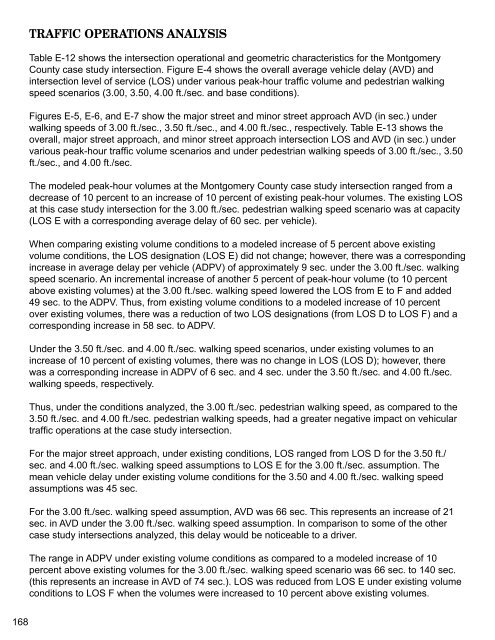Pedestrian Signal Safety - AAA Foundation for Traffic Safety
Pedestrian Signal Safety - AAA Foundation for Traffic Safety
Pedestrian Signal Safety - AAA Foundation for Traffic Safety
Create successful ePaper yourself
Turn your PDF publications into a flip-book with our unique Google optimized e-Paper software.
168<br />
TRAFFIC OPERATIONS ANALYSIS<br />
Table E-12 shows the intersection operational and geometric characteristics <strong>for</strong> the Montgomery<br />
County case study intersection. Figure E-4 shows the overall average vehicle delay (AVD) and<br />
intersection level of service (LOS) under various peak-hour traffic volume and pedestrian walking<br />
speed scenarios (3.00, 3.50, 4.00 ft./sec. and base conditions).<br />
Figures E-5, E-6, and E-7 show the major street and minor street approach AVD (in sec.) under<br />
walking speeds of 3.00 ft./sec., 3.50 ft./sec., and 4.00 ft./sec., respectively. Table E-13 shows the<br />
overall, major street approach, and minor street approach intersection LOS and AVD (in sec.) under<br />
various peak-hour traffic volume scenarios and under pedestrian walking speeds of 3.00 ft./sec., 3.50<br />
ft./sec., and 4.00 ft./sec.<br />
The modeled peak-hour volumes at the Montgomery County case study intersection ranged from a<br />
decrease of 10 percent to an increase of 10 percent of existing peak-hour volumes. The existing LOS<br />
at this case study intersection <strong>for</strong> the 3.00 ft./sec. pedestrian walking speed scenario was at capacity<br />
(LOS E with a corresponding average delay of 60 sec. per vehicle).<br />
When comparing existing volume conditions to a modeled increase of 5 percent above existing<br />
volume conditions, the LOS designation (LOS E) did not change; however, there was a corresponding<br />
increase in average delay per vehicle (ADPV) of approximately 9 sec. under the 3.00 ft./sec. walking<br />
speed scenario. An incremental increase of another 5 percent of peak-hour volume (to 10 percent<br />
above existing volumes) at the 3.00 ft./sec. walking speed lowered the LOS from E to F and added<br />
49 sec. to the ADPV. Thus, from existing volume conditions to a modeled increase of 10 percent<br />
over existing volumes, there was a reduction of two LOS designations (from LOS D to LOS F) and a<br />
corresponding increase in 58 sec. to ADPV.<br />
Under the 3.50 ft./sec. and 4.00 ft./sec. walking speed scenarios, under existing volumes to an<br />
increase of 10 percent of existing volumes, there was no change in LOS (LOS D); however, there<br />
was a corresponding increase in ADPV of 6 sec. and 4 sec. under the 3.50 ft./sec. and 4.00 ft./sec.<br />
walking speeds, respectively.<br />
Thus, under the conditions analyzed, the 3.00 ft./sec. pedestrian walking speed, as compared to the<br />
3.50 ft./sec. and 4.00 ft./sec. pedestrian walking speeds, had a greater negative impact on vehicular<br />
traffic operations at the case study intersection.<br />
For the major street approach, under existing conditions, LOS ranged from LOS D <strong>for</strong> the 3.50 ft./<br />
sec. and 4.00 ft./sec. walking speed assumptions to LOS E <strong>for</strong> the 3.00 ft./sec. assumption. The<br />
mean vehicle delay under existing volume conditions <strong>for</strong> the 3.50 and 4.00 ft./sec. walking speed<br />
assumptions was 45 sec.<br />
For the 3.00 ft./sec. walking speed assumption, AVD was 66 sec. This represents an increase of 21<br />
sec. in AVD under the 3.00 ft./sec. walking speed assumption. In comparison to some of the other<br />
case study intersections analyzed, this delay would be noticeable to a driver.<br />
The range in ADPV under existing volume conditions as compared to a modeled increase of 10<br />
percent above existing volumes <strong>for</strong> the 3.00 ft./sec. walking speed scenario was 66 sec. to 140 sec.<br />
(this represents an increase in AVD of 74 sec.). LOS was reduced from LOS E under existing volume<br />
conditions to LOS F when the volumes were increased to 10 percent above existing volumes.








